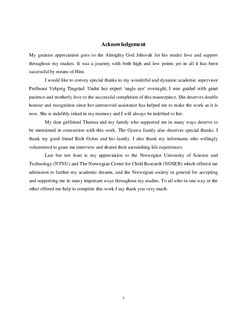To belong or not to belong? Exploring Processes of Integration among Immigrant Children in Norway
Master thesis
Permanent lenke
http://hdl.handle.net/11250/2457679Utgivelsesdato
2017Metadata
Vis full innførselSamlinger
Sammendrag
The aim of the study was to find out the various processes that immigrant children devise to do integration in the receiving society. The structural conditions within which they do integration were included in the search to understand those that promote and others that limit the individual efforts to do integration.
A sample of five immigrant children was recruited for the study using snowball method. Their ages ranged from 14 to 17 years. Using a semistructured life world interview, informants were individually interviewed and their narratives served as the empirical data for the analyses and discussions of the study. Each informant was made to understand the level of involvement in the research and willingly signed a consent form before conduct was made.
The main findings of the study covered three main areas. These were language, inclusion and citizenship. Language was seen as the master key of entrance to society and that without it, immigrant children will continue to remain outside of the receiving society. Inclusion was identified as another concern that these children had. Exhibited in excluding practices, immigrant children were sometimes left out of social gatherings by native children even if they desired to be part. The concept of citizenship and permanent legal status was among the worries that some immigrant children revealed challenges them as they do integration. State sponsored programmes designed to facilitate integration were seen as a major boast in the process of integration.
Based on the analyses, which employed Tuner’s concept of generalizable procedures, and the discussions of the findings, the study concludes that integration happens when immigrant children’s agency interrelates with the structural conditions of the receiving society. That is, integration is a function of agency and structural conditions in the receiving society.
